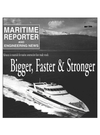
Page 12: of Maritime Reporter Magazine (May 1999)
Read this page in Pdf, Flash or Html5 edition of May 1999 Maritime Reporter Magazine
INVESTMENT IN DESIGN diesels of the widest-bore types, albeit with something less than the maximum number of cylinders, would be needed to guarantee schedule-keeping up to a top speed capability of 25-knots. An open- top configuration is being investigated, with special consideration of strength and seaway behavior.
A subsequent advance to 15,000-TEU, while technically viable in GL's view, would be subject still further to logisti- cal and port factors, and would neces- sarily demand turnround productivity possibly as great as 300 moves per hour and necessitating provisions for simulta- neous working of the vessel from both sides.
Such a behemoth of the liner trades, calling at a minimum number of main- line hubs, could spawn a requirement for vessels of 3,000-5,000-TEU to serve regional pivots and feeders of up to 1,500-TEU to sweep the minor ports.
Draft is a key control on future size, since access to many of the major termi- nals and ports requires that a vessel should draw no more than 46 ft. (14 m).
Interrelated with this criterion, Suez
Canal parameters dictate a maximum beam of 190 ft. (58 m) for a draught of 46 ft. (14 m).
On the basis of these considerations, believes HDW's Andreas Kraus, the top capacity for a future generation of con- tainerships in the foreseeable future would probably be around 11,000-TEU rather than 15,000-TEU, assuming a reasonable deadweight-to-slot relation- ship.
Speaking in London at the 'Design and Operation of Container Ships' con- ference organized by The Royal Institu- tion of Naval Architects (RINA), Kraus said that studies under the Container
Transport Systems of the Future pro- gram demonstrated the economic advan- tages of the 8,000-TEU size.
Evaluations of various designs from 4,970-TEU upwards at different speeds indicated the competitiveness of the 8,000-TEU type as regards fuel con- sumption per slot and nautical mile, with the best performance at 22 knots. Over- all transport costs, including transship- ment and hinterland stages, were also demonstrated to be lowest for an 8,000-
TEU vessel at 22 knots.
From a global logistics point of view, the German research project indicated an optimum service speed of between 24 and 25 knots for the largest linehaul ves- sels. In his joint presentation at the recent RINA gathering with Marc
Lebrun from Bureau Veritas entitled 'Design consideration of very large con- tainerships,' Wartsila NSD Switzer- land's Barend Thijssen confirmed the potency of the Sulzer RTA96C diesel. A single, 12-cylinder model, the most powerful engine in the company's exist- ing two-stroke range, direct-coupled to a single fixed-pitch propeller, could ensure the requisite speed for ships as large as 9,000-TEU.
It was pointed out that technical stud- ies including vibration analysis had demonstrated the feasibility of 13- and 14-cyUnder versions of the wide-bore engine design. In 14-cylinder format, the RTA96C would deliver 76,860-kW (104,580-bhp) at 100-rpm.
The question is whether a propeller that can transmit so much power is tech- nically feasible. "Today's containership propellers are coming closer and closer to the limits set by propeller-induced vibrations and by the manufacturing of the propeller itself," argued Thijssen and Lebrun.
From a two-stroke perspective, it is felt that the alternatives for ships in excess of 9,000-TEU are a twin-engine, twin-screw configuration, or a contra- rotating propeller arrangement. The con- siderable impact on capital costs of two massive low-speed engines instead of a single unit, however, could be a deter- rent in other than the most extreme sizes, i.e. of a minimum 13,000-TEU, it was suggested.
The contra-rotating propeller system option thereby warrants closer examina- tion by the industry.
Where enormous power concentra- tions are involved, it is felt that this holds certain potential benefits relative to a conventional single screw arrange- ment through higher propulsive efficien- cy, and therefore reduced installed power requirement and operating costs, and by offering a degree of redundancy and extra operational flexibility.
Circle 234 on Reader Service Card 12 Maritime Reporter/Engineering News
Do You WANT MAXIMUM PERFORMANCE
FROM YOUR DIESEL ENGINE?
PROTECT YOUR INVESTMENT.
When you've invested in the boat of your dreams, you need to protect the engine you depend on. FUEL MAG breaks down the sludge, algae and microbes that can clog filters and settle in tanks, contaminating the fuel. A one-time, maintenance-free installation increases filter life; reduces clogged injectors; extends diesel engine life and eliminates using toxic biocides.
Fuel Dynamics • P0 Box 523 • Cape Canaveral, FL 32920 • FAX (407) 784-5663
TOLL FREE (888) 825-4239
WEB SITE www.fueldyn.com
Dealer Inquiries Invited

 11
11

 13
13
